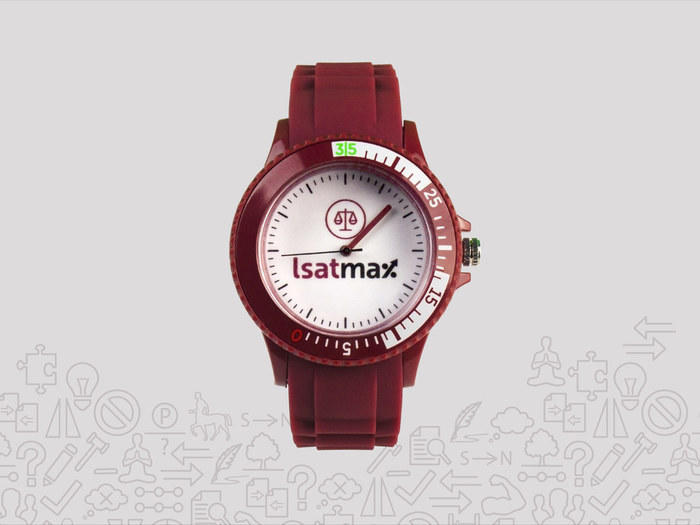What Are LSAT Timers?
There's no reason an LSAT timer would be any different from a regular timer. In fact, this phrase is a bit of a catchall for timers you can use while you're practicing or doing the LSATs. However, the timers you can use during the LSATs are different from those you can use at home for your own practice. Some timers are a bit more useful at home than others, as well.
Types of LSAT Timers
You basically have a few simple options for LSAT timers:
- Digital stopwatches
- Kitchen timers
- Wristwatches (analog or digital)
- Stopwatch apps
- Alarms or alarm apps
Anything that can be used to set an alarm to sound off after a certain time period is probably going to work out just fine for LSAT test prep. At home, you don't need to stress too much about time-keeping devices, because your options are nearly endless. Almost every electronic or device today has a clock on it, many of which come with alarm features.
However, it gets a little more complex when you're heading to LSAC to take the test.
Are LSAT Timers Allowed in Testing Centers?
At some point prior to the June 2017 LSAT, LSAC added "chronograph watches" to the list of prohibited test day items. Some "LSAT experts" have boldly proclaimed that this ban "includes all of the available LSAT watches out there."
Not surprisingly, this has caused many students to reach out to us and inquire if this new ban has affected the LSATMax Analog LSAT Timer. The good news is no! Our LSAT analog watch is still an approved test day timer.
Here is the exact terminology used on LSAC's website:
"You MAY NOT bring into the testing center or use any of the following:
digital watches, alarm watches, beeping watches, calculator watches, chronograph watches (digital or nondigital)"
So, our LSAT vocab word of the day is "chronograph."
According to Wikipedia, "a chronograph is a specific type of watch that is used as a stopwatch combined with a display watch. A basic chronograph has an independent sweep second hand; it can be started, stopped, and returned to zero by successive pressure on the stem."
Examples of a chronograph LSAT watch include the Mastermind Watch ($68.99) and the 180Watch ($49.99). When you see the ridiculous price points of these watches, you quickly realize that LSAC actually did LSAT students everywhere a favor by enacting this ban.
The LSATMax Analog LSAT Timer is not a chronograph. It is an analog timer with no LSAC-prohibited functionality.
To further put your mind at ease, none of our students have reported any issues at their testing center with our watch on the June 2017, September 2017 or December 2017 LSAT.
Rest assured, you can keep living your life 35-minutes at a time!
Timing with Analog Watches
Although you don't have the alarm feature to audibly tell you when your time is up, or to give you updates as you go, you can still use an analog watch effectively. The most useful type are analog watches with rotating top bevels. You can rotate the bevel on top to wherever the minute hand happens to be. This allows you to track 35 minutes without having to adjust the actual hands of the watch at any point. It's simpler to do, so your timepiece won't add stress to an already stressful test.
Should You Practice with an LSAT Timer?
You should absolutely be practicing your LSATs with an LSAT timer! If you don't use a timer during practice, you have no way of knowing if you're within the right time parameters to take the test successfully. No matter how many right answers you get or how well you do on each section, you need to add a timer to the mix to truly see how you might do on the actual test.
Timing yourself when test-taking is stressful, but it's a necessary part of the LSATs. You don't have a lot of time to complete the test. Each section gives you only 35 minutes to complete every question. If you don't practice each section with a timer, how will you know if you can complete the actual test within the time constraints?
When to Start Using an LSAT Timer
While you do need to practice with the timer, you shouldn't start out timing every section. Start without using a timer on every section except the logic games. If you start using a timer on every section right away, you can stress yourself out unnecessarily and taint your practice. Save the timer until you're a little more proficient on each practice section. First focus on learning how to do the test sections well, then add the timer into the mix to cut down your time.
The only exception to this is the logic games section. Once you've read over how to do these sections efficiently, you can start immediately practicing with the timer. Use a timer the first or second time around to gauge where you're at and see how much progress you need to make to be within the time limits set by LSAC.
How to Think about LSAT Times
The test has a total time limit of 175 minutes (35 minutes x 5 sections). You can think about it like this, but you need to break it down into different parts. You'll only be at the LSAC center for a bit longer than 175 minutes in total to take the test. But, each test is broken down into 5 different timed sections. These are the constraints you need to pay more attention to.
No matter how quickly you complete 1 section, you won't be given extra time on another. If you're too slow in a section, you won't be penalized in the next. Time constraints for each section are strict, so you need to work on your test-taking with this in mind.












